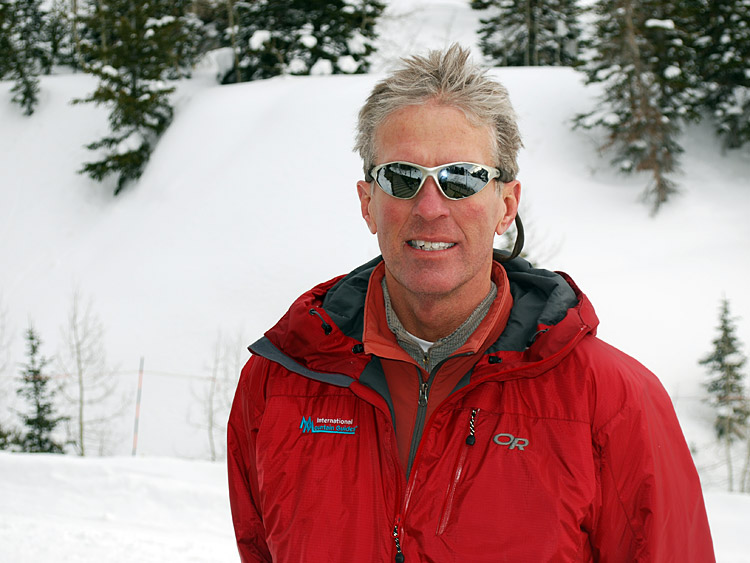
Backpacker Magazine
July 25, 2010

George Dunn Rainier's Reigning Champ
by Steve Howe, Backapacker Magazine
George Dunn, co-owner of International Mountain Guides, recalls personal adventures and gives tips about climbing Mount Rainier.

George Dunn has climbed Mount Rainier over 500 times
Just one ascent of 14,411-foot Mt. Rainier is a formidable feat. George Dunn, 57, has climbed it a record 501 times and counting (he notched number 500 last July). Along the way, he's helped 10,000-plus climbers top out. Here's what Dunn has to say about life, leadership, and staying safe.
On the 500th ascent, my wife, youngest son (16), and a few partners came along. That was cool.
I never meant to climb it so many times, but Rainier is my backyard and my job.
I was born in Wichita, Kansas, but my family moved to Washington when I was four. At about 15, my high-school climbing club introduced me to basic skills. Then at the University of Washington, I met other climbers, some of whom became lifelong partners. I needed a summer job, so I tried out with Rainier Mountaineering, Inc. I loved it and have been a full-time guide since 1975. My friends Phil Ershler, Eric Simonson, and I started IMG in 1986.
I've never been seriously injured, but I've been involved in a few accidents and rescues over the years. That's reinforced for me that we go into the mountains to have fun, not to die or generate interesting epics. It's all about coming home at day's end. I guess that marks me as a guide, not a cutting-edge climber.
Mountains strip people of their trappings, titles, and occupations. You see people as they really are.
Even in good weather, Rainier has been described by the underprepared as a death march—a long, hard endurance climb with hazards like avalanches, crevasse falls, whiteouts, and rapid ascents to altitude that many underestimate because of the mountain's easy proximity. Bad storms can brew any time of year. I've seen storms dump several feet of snow in a day every month of the year.
The most common mistake aspiring climbers make is glossing over the possibility of accidents. Not having a backup plan. Not looking at weather forecasts or preparing for worst-case scenarios.
Look, it's 18 miles round-trip and 9,000 vertical feet. The only way to prepare for that is to train as specifically as you can. On the first day's hike to Camp Muir, for example, you need to hike 4,500 vertical feet in about 4.5 miles. So I tell people to pick a similar trail [if you live near mountains] and train on it at least once a week. Slowly increase your speed and pack load. Whenever you can, get out of the gym and onto a trail where you have to worry about balance and footing. If you live in Florida, run sand dunes, run stairways, hike up and down hills.
The mark of a good private group is that they've trained together, climbed together, learned together, and developed their skills as a party.
I wouldn't be telling the truth if I said the hike to Camp Muir was fresh and new, but when I climb with people seeing the mountain for the first time, I get to experience it through their eyes.
John Kennedy Jr. climbed with us one icy day. We turned back high on the mountain. He was a real gentleman—very low key and fun to be with.
I remember one guy with a prosthetic leg and how hard he struggled climbing over loose rock. I also worked with a one-armed guy figuring out how to self-arrest one-handed with an ice axe. I'm inspired by anyone who comes back after failure more prepared and ready to give it another crack.
The best moments are when I'm descending from any tough peak, and I get the chance to look around, enjoy the setting, and think, "Gee, it's great to be alive."
Mountaineering is my passion; it's fun, it's fitness, and I enjoy it as a business, but I don't mistake climbing for life itself. I'm grounded by having a wife and two sons. That's what life is all about.
The trick is never to stop. My body holds up fine during the season. It hurts in the fall, when I slack.
These days, I'm a full-time guide service owner, not a full-time guide, so I'm in the office way too much. I'm just coasting along, doing another climb or two every month, and I'll be content to do that the rest of my life.
George Dunn's Top 5 Rainier Tips
- Start training six-plus months in advance. Once a week or more, do a four- to six-mile hike with 1,000 feet of gain per mile, working up to expected pack weight (35-50 lbs.)
- Take classes for skills like first aid, glacier rescue, and routefinding.
- Weed out nonessential gear.
- Pack for bad weather, no matter the forecast.
- Allow time to take photos, sightsee, and enjoy.
© The News Tribune